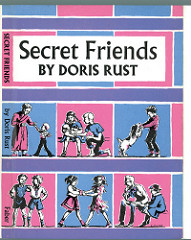Inspiring Young Readers
 posted on 23 Nov 2018
posted on 23 Nov 2018
Secret Friends by Doris Rust
I wonder how many of you were given the classic classroom creative-writing task of writing ‘A day in the life of a penny’ or something similar? I’ve often thought it would have been a much more fascinating exercise to be asked to imagine the life of an old book – they are, after all much more characterful than a coin and they usually come stuffed or crusted with clues.
However, when I stumbled across this 1962 Faber and Faber edition of Doris Rust’s Secret Friends my theory that books are uniquely characterful was dealt something of a blow. This book is still virtually mint, the jacket is pristine and I’d be willing to bet that until I came along no-one had read it. The only sign it had been pre-owned was an inscription hidden on the inside front board paste-down behind the jacket flap which read ‘Charlotte Huntington Whitely from Ripple Sunday School 1973’ - and clearly Charlotte hadn’t been very impressed by the gift and it remained on a shelf until it was stuck in a box and got rid of.
Secret Friends is aimed at younger readers and consists of six stories of children who have created imaginary friends who come to them when they are bored or in times of stress. None of the stories have any complexity – in fact, quite the opposite – and none of them run past four or five pages including illustrations.
I’m aware that I’m making this book sound rather gentle and cosy and I suspect that’s exactly what author, illustrator and publisher were aiming at. But, I have to tell you, something slightly odd happened at some point during the writing of the book and what we’ve ended up with is, at times, inadvertently sinister. Take, for example, the first story in the collection, Jacky and Pippet. Jacky is ill in bed and he’s bored because he wants someone to talk to – his mom is busy around the house and his dad is out at work. So he calls out to Pippet, his imaginary friend who, get this, slides in through a crack in the window pane and unfolds himself by hanging from the wall like a picture:
“There, flat against the wall, as if he were a picture hanging without a cord or a nail, was a tiny man with fuzzy hair and bright eyes.”
The illustration (see below) actually makes Pippet look like something from a Stephen King mini-series. And, it turns out, Pippet isn’t happy that Jacky’s been ignoring him and there’s a distinct air of the homicidal Chocky about this imaginary friend. You’re left with the uneasy impression that just a minor tweak would turn this story from a little diversion for young children into a horror story.
And this is a theme that runs through at least four of the six stories with only the final one – Jane and the Boat Boy - being anodyne enough to qualify as a safe goodnight tale. Susan and Goldie has all the ingredients of a ghost story while Simon and Moppety flirts with devilish possession. But the spookiest by some distance is Rosemary and Mr. and Mrs. Milkins in which an imaginary elderly couple - dressed in their outside clothes of overcoats and hats and complete with shopping bags come to Rosemary to reassure her in the night and help her overcome her fear of the dark:
“’I’m not afraid any more,’ Rosemary told him. ‘Now that you and Mrs Milkins are here I don’t mind a bit. You see, I don’t really like the dark.’
‘Don’t like the dark?’ Mrs Milkins repeated, shaking her round head and looking extremely surprised. ‘Now I find that very odd. The dark is fun. The dark is exciting.’ She paused. ‘The dark is wonderful.’”
How did this tale leap from a copy of 'Tales of the Unexpected' straight into a children's book about imaginary friends?
Very weird. And I can’t help but think old Doris Rust knew what she was up to here. I find it hard to believe that this flirtation with the dark-side was missed by everyone concerned in the production of the book and so you have to conclude that there was a deliberate bit of grit being slipped into the oyster.
An added bonus that does nothing to dial down the oddness are the illustrations by Cecil Elgee, who also designed the jacket. The artist worked with Doris Rust on a whole range of children’s story collections. Elgee was herself an interesting character who is worth checking out as an artist in her own right and you’ll find an interesting profile of her on this link.
Sadly, the book is out of print now but you will find copies on the second hand market but be prepared to pay anything from £10 - £20.
Terry Potter
November 2018
(click on any image below to view them in a slideshow format)



